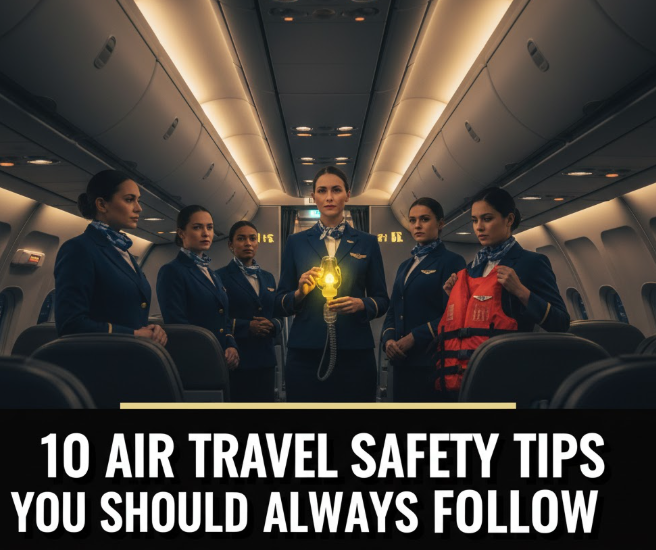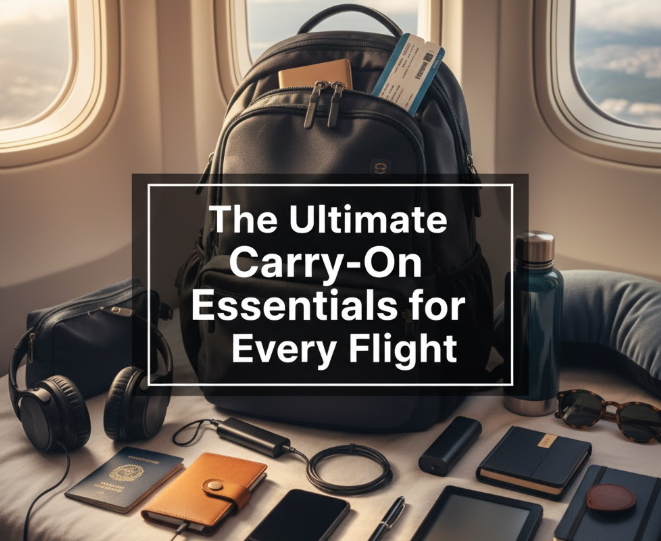When you’re routinely hopping on and off planes, flying can be second nature, but it’s also easy to forget the safety precautions in the routine airline rush between airports or seats. Whether you’re a white-knuckled flier or an airplane aficionado, learning and observing some basic air travel safety tips can do wonders for your trip. These rules aren’t just about airline regulation — the goal is to help keep you and everyone else on your flight safe.
Air travel is one of the safest means of transport, but only because passengers and crew members take its inherent risks seriously. From the time you book your ticket to when you retrieve your luggage, there are basic precautions travelers can adopt for added protection and a smoother trip. Here are ten important safety tips travelers need to consider before taking off on a trip.
1. Where You Sit Matters for the Ultimate in Safety
The seat you choose to sit in on a plane matters more than you might think. Even though safety standards are strict on every seat, there are more optimal spots in the plane during an incident.
The best seats on a plane are those in at least the first five rows behind the emergency exit. Studies have indicated that passengers in these seats are more likely to survive a serious incident, because they are able to evacuate faster. Aisle seats also offer you quicker access to the exits compared with window or middle seats.
Avoid exit row seats altogether if you’re traveling with children — these seats come with duties during evacuations and passengers must be able to physically open the heavy, bulky doors. Opt, instead, for back-of-the-plane seating wherever you can. Research into aviation accidents has shown that rear seats can be safer than front seats.
When choosing your seat, keep the following in mind:
- If you’re reasonably able-bodied and don’t mind the responsibility of an exit aisle seat, take an aisle seat for easier evacuation
- When considering which seat to choose, make sure it gives you quicker access to the exit
- Don’t sit in the bulkhead if you have items to store under the seat in front of you
- Rear cabin seats make more sense statistically for better safety opportunities
For more travel tips and booking assistance, visit Call to Flights.
2. Seatbelt On At All Times During The Whole Flight
You’ve probably read this (or heard it announced by a flight attendant) because it’s almost too obvious: Just because the seat belt sign is off doesn’t mean you should unbuckle. That’s a mistake. Turbulence can come out of nowhere, even if the sky appears cobalt-clear.
While you’re seated, keep your seatbelt fastened even during smooth flights. Turbulence leads to dozens of injuries each year — mostly to passengers who were not wearing their seatbelts. Turbulence is among the top causes of in-flight injuries, flight attendants say.
Ensure your belt is tight and placed in a position across your lap, not the stomach. When you’re sleeping, just leave it buckled over your blanket so the flight attendant knows you are belted in without having to wake you.
What About During Bathroom Breaks?
And of course you’ll have to unbuckle when you head to the lavatory, or just feel like stretching your legs. That’s fine. The trick is to buckle up as soon as you get back in your seat. Should turbulence strike while you’re standing and walking around, gripping the backs of seats for stability, make your way carefully back to your seat as quickly as you can.
3. Listen to the Safety Demonstration: Pay Attention During the Safety Demonstration
Yes, you’ve seen it before. Yes, it seems repetitive. But the safety demonstration includes some information that could save your life.
Each aircraft type is somewhat unique. The exits, the oxygen mask — how you put it on, how much slack is there before it starts pumping oxygen — where’s the life vest are different for each plane. Even if you do fly often, you could be on an aircraft type with which you are unfamiliar or have different emergency procedures.
Why the safety briefing matters:
- Exit points vary according to aircraft and where you are seated
- How the oxygen masks work differs on different planes
- The position of flotation devices varies depending on the type of aircraft
- You find out how close the nearest emergency exit is to your seat
Set your phone down, unplug the earbuds and give attention for those few minutes. Notice where the nearest exits are — the closest to you, of course, might be behind you. Count the number of rows between your seat and that exit. You may need to worm your way out of a smoky cabin, and being able to count off how many rows you’ve crawled could save your life.
Safety Equipment Overview
| Equipment | Location | When to Use |
|---|---|---|
| Oxygen Masks | Overhead compartment | When there is a drop in cabin pressure |
| Life Vests | Under your seat or in the seat pocket | Underwater only (not before) |
| Emergency Exits | Multiple locations throughout cabin | Any emergency evacuation |
| Escape Slides | At each exit door | Evacuations with aircraft on ground/water |
4. Don’t Take Off Your Shoes During Takeoff and Landing
Perhaps you want to kick your shoes off once you are settled in for a long flight, but it’s all about the timing. The two most important parts of any flight are takeoff and landing — that’s when more accidents occur, if they’re going to.
Wear your shoes when you’re boarding, and take them off after the plane has reached a cruising altitude; put them back on again when the plane is about to land. If you have to leave during an emergency evacuation, you may have to run across what could be hot tarmac or dodge broken glass. Socks and bare feet will not save you.
That doesn’t mean during the flight you can’t get comfortable. Once you’ve reached cruising altitude, by all means change into comfortable slippers or socks. Just make sure you can get your proper shoes back on fast when necessary. Store them close at hand rather than buried deep in an overhead bin, where it can be a tight squeeze.

5. Store Your Carry-On Properly
A bag falling on its own can do some serious damage. Even worse, improperly stowed luggage can obstruct aisles and exits in emergencies, stalling evacuations at a critical moment.
Follow these carry-on storage guidelines:
- Store heavier bags up top, not below the seat in front of you
- Ensure overhead bins close with a click
- Put things you will use during the flight (medications, phone, headphones) in the seat pocket or under the seat
- Never overstuff overhead bins — check at gate if your bag doesn’t fit comfortably
- Pack sharp or heavy objects, such as scissors, in your checked suitcase — not carry-ons
Only small personal items like a purse or laptop carrier fit under the seat in front of you. This maintains a clear space at your feet to brace for an emergency landing. It also means that you are not blocking your own legroom, which will be necessary for evacuating the aircraft rapidly.
What to Keep Accessible
Carry important items in trouser/sweater pockets or the seat pocket: passport, phone, wallet and critical medications. In an emergency evacuation, you and your fellow passengers won’t have time to grab bags out of overhead bins — you’ll be told to abandon everything.
6. Follow All Crew Instructions Immediately
Flight attendants are not just there to serve drinks. They are highly trained safety professionals subjected to extensive emergency preparation courses. When they provide instructions, particularly in life-threatening situations, the ability to act on them promptly and fully can mean the difference between safety and peril.
Listen to instructions, and if a crew member instructs you to brace for impact, take the brace position at once. If they tell you to evacuate, proceed quickly toward exits without trying to take your things with you. If they say to return to your seat and put on your safety belt because of turbulence, do so immediately.
Flight attendants are specifically trained to deal with the following:
- Medical emergencies
- Ground and water evacuations
- Fire suppression
- Security threats
- Severe turbulence events
- Decompression situations
So never argue with a flight attendant or hesitate when they tell you what to do. They have situational details that you don’t, and they’re trained to make snap judgments in the name of protecting the safety of their passengers. During an emergency, seconds matter.
7. Pay Attention and Keep Drinking to a Minimum
High altitudes change how alcohol affects your body when you fly as well. As the cabin has lower pressure and there’s less oxygen in your body, alcohol will affect you a lot quicker than it would on land. At 35,000 feet, what would be a mildly relaxing beverage on the ground can impair your judgment and slow your reactions.
Why staying alert during flights counts:
- If an emergency situation arises, you’ll want to act promptly
- Alcohol can exacerbate jet lag and dehydrate you
- Intoxicated passengers are unlikely to comply with safety instructions
- On long flights, alcohol raises your chance of experiencing deep vein thrombosis (blood clots)
If you do decide to drink, stick with one or two drinks at most and hydrate with plenty of water in addition. Keeping yourself hydrated is good for your health anyway when flying, as cabin air is very dry.
It’s particularly important on long-haul international flights. And while you might be tempted to have a few drinks before bed in an attempt to sleep, being heavily sedated or drunk during an emergency can significantly reduce your ability to evacuate safely.
Learn more about aviation safety regulations from the FAA.
8. Understand the Use of Emergency Equipment
In the safety demonstration, you will be shown different pieces of emergency equipment. But do you actually understand your way around it? Let’s break down the essentials.
Oxygen Masks
Should the oxygen masks above your head deploy, pull a mask straight down — this action releases the flow of air. Slip it over your nose and mouth, then secure the elastic band behind your head and breathe normally. The bag won’t inflate completely, but oxygen is flowing. Put on your own mask first, even before helping children.
Life Vests
Life vests are under your seat or in the seat pocket. Use them only after getting out of the plane — inside a plane that’s going down, they could pin you to the ceiling. Inflate manually by pulling the string, or inflate with ease using the tube to blow air.
Emergency Exits
They are heavy metal doors and require some degree of effort to open. If you are in an exit row, you have agreed to help people evacuate. Know how to operate the door by reading the safety card in your seat pocket.
9. Keep a Personal Safety Plan
Your emergency moment can come with little warning. Create a mental image to use prior to every flight focusing on safety. This easy practice can dramatically increase your reaction time when faced with a crisis.
Your pre-flight safety checklist:
- Count the rows to the nearest two exits (one in front, one behind) from where you are seated
- Imagine evacuating in the dark or through smoke — how would you locate the door?
- Consult the safety card in your seat pocket for aircraft-specific information
- Remember where your shoes are and that they can be put on quickly
- Keep your phone charged but on airplane mode for emergencies
Maintain an attitude of awareness during the flight. Observe whether the crew members seem worried or are clustering for discussions. You should be alert to odd noises or smells. Most flights are perfectly normal, but it helps to be alert to anything that might seem out of place.
The 90-Second Rule
Safety standards for airlines stipulate that all aircraft must be evacuable within 90 seconds using only half the available exits. Things happen quickly during evacuations. Don’t try to retrieve baggage. Don’t stop to take photos. Don’t crowd or push. Listen to crew members and move with purpose, but not in a run; lend assistance if you can do so without putting yourself at risk.
10. Protect Yourself and Prepare for Health Concerns
Air travel takes a toll on your body in unique ways. The cabin pressure, the dry air and the amount of time spent sitting can all have an impact on your health — especially if you have an underlying condition.
Health precautions for safe flying:
- If you have a heart condition or breathing problem, or are recovering from recent surgery, consult your doctor before flying
- Get up every few hours on long flights to avoid blood clots
- Keep yourself well-hydrated by drinking plenty of water
- Let flight attendants know immediately if you feel that your symptoms are severe
- Pack life-saving medications in your personal item, not checked luggage
- Wear compression socks on long flights to help circulation
If you see another person having a medical emergency, tell the flight attendant right away. They are trained in first aid and CPR, and can call for medical help from any doctors or nurses who happen to be on board.
Cabin crew are also equipped with emergency medical kits and automated external defibrillators (AED). The sooner they know about an illness, the quicker they can offer life-saving help too.
Comparison: Safety Features Between Types of Aircraft
| Aircraft Type | Number of Emergency Exits | Special Safety Features | Typical Range |
|---|---|---|---|
| Small regional (50-100 seats) | 4-6 | Reduced descent rate, faster evacuation | 1-3 hours |
| Narrow-body (100-200 seats) | 6-8 | Basic safety equipment | 3-6 hours |
| Wide-body (200-400 seats) | 8-16 | More aisles, exits and medical kits | 7-14 hours |
| Double-decker (400+ seats) | 16+ | Dual-level evacuation, enhanced fire containment | 7-18 hours |
Frequently Asked Questions
Which is safer to fly in: night or daylight?
From a statistical standpoint, the time of day does not have much effect on flight safety. Both modern aircraft and navigation systems function just as well during the day as at night. But some passengers prefer the light of day, when they can see outside.
What is the safest seat on an airplane?
Seats in the back third of the aircraft, or those within five rows of an emergency exit, offer the best odds of survival in serious incidents, research shows. But every seat on a commercial plane is highly safe.
May I use my phone during takeoff and landing?
Your phone must be in airplane mode when you are on the plane, so as not to disrupt communication systems. But the majority of carriers now allow passengers to use their own personal devices at all phases of a flight as long as they’re in airplane mode.
What if I see something suspicious?
If you feel unsafe, or notice any security issue, promptly report the matter to flight attendants. It’s always better to speak up — crew members would much rather follow up a false alarm than ignore a true threat.
How often does an aircraft get a “check-up”?
Commercial planes are subjected to daily pre-flight checks, with more detailed inspections every few days, and in-depth maintenance checks at regular intervals. Aviation companies must adhere to schedules given by air regulation control units.
Is turbulence dangerous?
Turbulence is unpleasant but seldom poses a danger to the plane itself, which is designed to tolerate much worse. The one risk is to unbuckled passengers and flight attendants. That is why it is so important to keep your seatbelt fastened.
What if both engines fail?
Modern airplanes are able to glide for a long way without an engine, and pilots are trained extensively on this event. Multi-engine aircraft are engineered to fly safely with one engine if necessary. Total engine loss is extremely rare.
Is air quality a concern on planes?
Many modern planes are equipped with HEPA filters, which can remove more than 99% of airborne particles, including most viruses and bacteria. The cabin air is completely refreshed every 2-3 minutes, cleaner than many indoor environments.

Conclusion: Safety Starts With You
The safety of air travel is not the sole responsibility of pilots, crew members and maintenance staff — but passengers as well. By remembering and following these ten important safety tips you’re not only protecting yourself, but helping to keep safe everyone on your flight.
Keep in mind: Airlines invest heavily in safety training, equipment and procedures since passengers’ safety is their first priority. But these systems depend most on passengers being informed, vigilant and helpful. Spending a few minutes before takeoff learning about how to have the safest flight possible, choosing your seat wisely and staying aware during the flight can all make a significant difference.
Make sure to take these tips with you on your next flight and incorporate them into your pre-travel routine. Flying is incredibly safe, and following these rules will make it even safer for you and your fellow passengers. Bon voyage, and just remember — those few minutes preparing for safety can be invaluable on your journey.
For more travel information and flight bookings, visit Call to Flights






